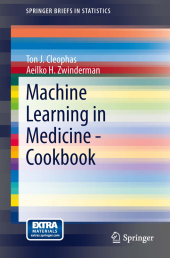 Neuerscheinungen 2014Stand: 2020-02-01 |
Schnellsuche
ISBN/Stichwort/Autor
|
Herderstraße 10
10625 Berlin
Tel.: 030 315 714 16
Fax 030 315 714 14
info@buchspektrum.de |

Ton J. M. Cleophas, Aeilko H. Zwinderman
(Beteiligte)
Machine Learning in Medicine - Cookbook
2014. 2014. xi, 137 S. 14 SW-Abb. 235 mm
Verlag/Jahr: SPRINGER, BERLIN; SPRINGER INTERNATIONAL PUBLISHING 2014
ISBN: 3-319-04180-0 (3319041800)
Neue ISBN: 978-3-319-04180-3 (9783319041803)
Preis und Lieferzeit: Bitte klicken
This timely guide explains how to derive the most benefit from automatically mining the vast, and growing, quantities of information in medical databases. It lays out the fruits of the authors´ expertise in a condensed, easily consulted format.
The amount of data in medical databases doubles every 20 months, and physicians are at a loss to analyze them. Also, traditional methods of data analysis have difficulty to identify outliers and patterns in big data and data with multiple exposure / outcome variables and analysis-rules for surveys and questionnaires, currently common methods of data collection, are, essentially, missing.
Obviously, it is time that medical and health professionals mastered their reluctance to use machine learning and the current 100 page cookbook should be helpful to that aim. It covers in a condensed form the subjects reviewed in the 750 page three volume textbook by the same authors, entitled "Machine Learning in Medicine I-III" (ed. by Springer, Heidelberg, Germany, 2013) and was written as a hand-hold presentation and must-read publication. It was written not only to investigators and students in the fields, but also to jaded clinicians new to the methods and lacking time to read the entire textbooks.
General purposes and scientific questions of the methods are only briefly mentioned, but full attention is given to the technical details. The two authors, a statistician and current president of the International Association of Biostatistics and a clinician and past-president of the American College of Angiology, provide plenty of step-by-step analyses from their own research and data files for self-assessment are available at extras.springer.com.
From their experience the authors demonstrate that machine learning performs sometimes better than traditional statistics does. Machine learning may have little options for adjusting confounding and interaction, but you can add propensity scores and interaction variables to almost any machine learning method.
Cluster Models
1 Hierarchical Clustering and K-means Clustering to Identify Subgroups in Surveys (50 Patients)
2 Density-based Clustering to Identify Outlier Groups in Otherwise
Homogeneous Data (50 Patients)
3 Two Step Clustering to Identify Subgroups and Predict Subgroup Memberships in Individual Future Patients (120 Patients)
Linear Models
4 Linear, Logistic, and Cox Regression for Outcome Prediction with Unpaired Data (20, 55, and 60 Patients)
5 Generalized Linear Models for Outcome Prediction with Paired
Data (100 Patients and 139 Physicians)
6 Generalized Linear Models for Predicting Event-Rates (50 Patients)
Exact P-Values
7 Factor Analysis and Partial Least Squares (PLS) for Complex-Data Reduction (250 Patients)
8 Optimal Scaling of High-sensitivity Analysis of Health Predictors
(250 Patients)
9 Discriminant Analysis for Making a Diagnosis from
Multiple Outcomes (45 Patients)
10 Weighted Least Squares for Adjusting Efficacy Data with
Inconsistent Spread (78 Patients)
11 Partial Correlations for Removing Interaction Effects from
Efficacy Data (64 Patients)
12 Canonical Regression for Overall Statistics of Multivariate Data (250 Patients) Rules Models
13 Neural Networks for Assessing Relationships that are Typically Nonlinear (90 Patients)
14 Complex Samples Methodologies for Unbiased Sampling
(9,678 Persons)
15 Correspondence Analysis for Identifying the Best of Multiple Treatments in Multiple Groups (217 Patients)
16 Decision Trees for Decision Analysis (1004 and 953 Patients)
17 Multidimensional Scaling for Visualizing Experienced Drug Efficacies (14 Pain-killers and 42 Patients)
18 Stochastic Processes for Long Term Predictions from Short
Term Observations
19 Optimal Binning for Finding High Risk Cut-offs (1445 Families)
20 Conjoint Analysis for Determining the Most Appreciated
Properties of Medicines to Be Developed (15 Physicians)
Index


